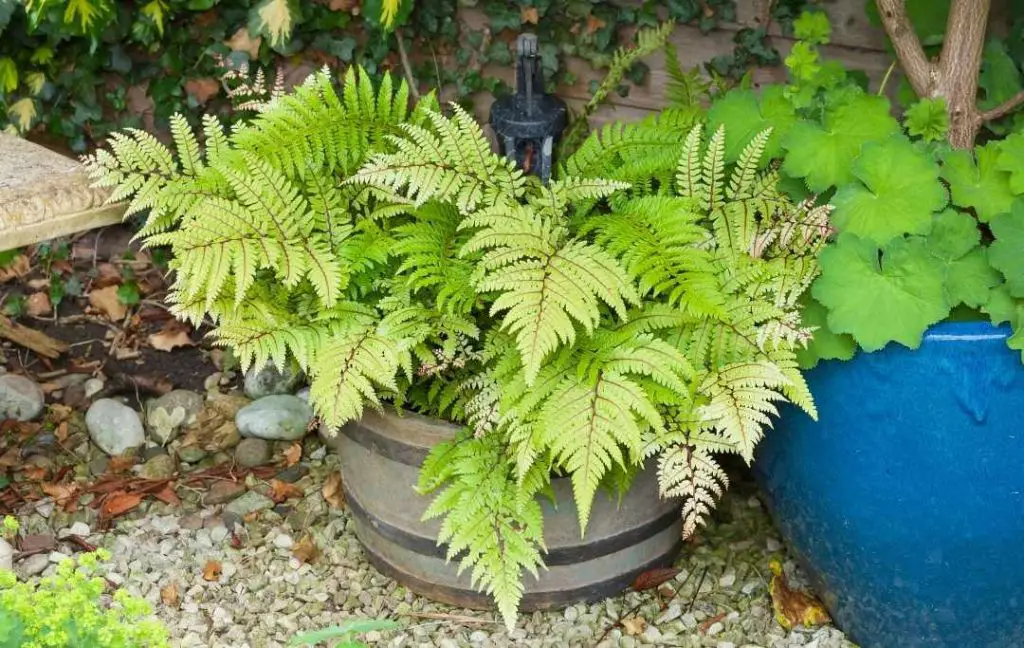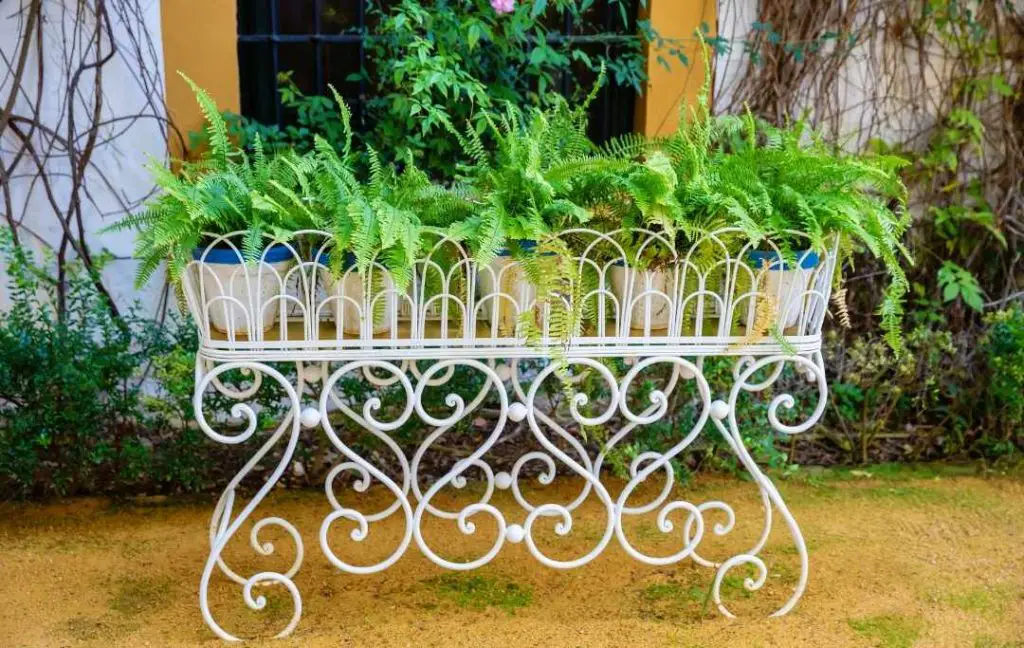If you want to add delicate and feathery texture to your growing area then you should choose ferns. Ferns have an extremely forgiving nature and they show strong survival instincts.
This low-maintenance plant needs well-drained and rich soil for healthy growth. If your soil has organic matter then ferns grow to fail. One important thing about ferns is that they will grow where other plants fail to grow.
Ferns are such types of plants that have nearly 12000 species. It is a unique category of plants that do not grow by seeds. The ferns propagate through spores.

These are reproductive units that are just like dots. These spores are present on the underside of the fronds. The spores of ferns drop onto the ground but only a few of them will grow.
The lace-like leaves of ferns are known as fronds. You can easily plant ferns in a hanging basket or as ground cover. It depends on the space you have. Ferns can bring tropical ambiance to your home garden. The moist and shady place is perfect for growing ferns.
How To Care For Ferns?
There are different shapes and sizes of ferns available but all types of ferns demand the same care. If you add them to your outdoor garden then it will enhance your outdoor area’s beauty. Here we are going to discuss some tips and ideas with you for caring for outdoor ferns.
1- Select The Right Fern

The selection of the right variety is very important before growing ferns. There are many types of ferns available but you should choose the one which fits your needs.
If you have a limited area for growing ferns, you should avoid choosing aggressive ferns like Ostrich Fern and Sensitive Ferns. These types of ferns need a lot of ground to cover.
You can easily grow fern outdoors in your garden. They can grow in the company of woodland plantings such as hosta, liriope, columbine, and caladiums. The caring of ferns depends on the type you choose.
Different species of ferns have different characteristics and cultural needs. Some varieties have giant tree-like plants while on the other hand, some can only grow above one inch. The most common varieties of ferns that you can choose for outdoor growing are as follows.
a- BOSTON FERN
This is an evergreen perennial herbaceous fern. You can grow this fern in a hanging basket easily. This is also best for growing indoors as a houseplant.
If you provide the best and right conditions to Boston ferns then they will flourish. The cool climate is best for this type of fern. You should choose that place where it gets a partial shade or full shade. Direct sun can easily scorch the fronds.
b- LADY FERN
This is a low-maintenance plant that has lush bright green foliage. The stalks of fronds have different shades such as red, purple, and green. The height of this variety can be reached 2 to 5 feet.
Keep it in your mind, the rhizomes and fronds of this variety are poisonous. If you have a pet then you should avoid planting this type of fern in your garden.
c- OSMUNDA FERN
This is the tallest variety of ferns. The moist and shady area is best for this type of fern. This is recommended for growing outdoors, not indoor areas.
d- WOOD FERN
This is an adaptable variety of fern because of its tolerance. It can survive in various light conditions. This is a medium-size hardy variety and drought-tolerant when mature. If you are growing fern for the first time then this variety is the right choice for you.
e- Southern Maidenhair Fern
This variety is a hardy-spreading plant that can survive any type of soil. It can grow well in rocky and acidic soil. This fern has a delicate look and appearance.
The dark strips and bright green color attract others to your garden. You should prefer moist soil with rich organic matter and if you are living in a humid climate then your ferns thrive well in all these favorable conditions. Avoid direct sunlight areas and choose a shady place for them.
2- Place In Indirect Light
A dense shade or bright light is not good for ferns as they cause stress in them. They prefer to grow in a dappled shade, bright and indirect light. The sunlight of the morning or gently filtered light through tall trees of your garden is perfect.
Avoid growing ferns in full sun, the front porch is not a suitable place for growing ferns. You should choose a side or back porch for growing ferns so you will protect them from the harsh sun rays. For the center of your growing area, you should choose those plants which can tolerate full sun.
3- Water Your Fern Regularly
Moist soil is needed for the growth of ferns, which means your soil needs regular water to maintain moisture. The bright green healthy glow is maintained with the help of a regular and consistent water supply.
The watering schedule of your fern plants depends upon how you plant them. If you are growing your fern plants in a basket or pot, you will see the soil will dry out quickly.
In such a case, you have to increase the amount of water. Overwatering should be avoided because wet soil is not recommended for the healthy growth of your fern plants.
If you want to prevent your plants from the diseases which are caused by wet soil then you should determine the frequency of water that your ferns need.
If in your area rainfall is not doing its job then you can increase the amount of water. In humid areas, you have to limit the amount of water.
Read More
- HOW TO GROW PEONIES FROM CLIPPINGS?
- HOW TO GROW KIDNEY BEANS IN A POT?
- HOW TO GROW HYDRANGEAS IN CONTAINERS?
4- Fertilize Monthly
Most of the ferns don’t need fertilizer on a regular basis. But if you see that there is no new growth in your ferns, you can use slow-release fertilizer once a year in the spring season.
The amount of fertilizer should be 1 tablespoon per 1 square foot. The thickness of the layer of fertilizer should be 1 to 3 inches. If you transplanted ferns in the fall then there is no need for rich fertilizer at that time.
If the fronds will turn brown along the edges then you should reduce the amount of fertilizer. In case your ferns start to look burnt then increase the frequency of water.
If you are living in a hot climate then ferns need a monthly dose of fertilizer. Water-soluble and nitrogen-rich fertilizer is recommended for your fern plants. You can mix 1 tablespoon of water-soluble fertilizer per gallon of water. The right fertilizer is very essential for ferns.

5- Pests Problems
Few pests are a problem for outdoor ferns. Scale insects and mealybugs can become a headache for you. If you buy pest-free plants from a local nursery then there will be no issue of pests.
Make sure you provide all the basic requirements of ferns because in this way they will become more resistant to pests. Pesticides are not good for ferns so it is not recommended for you to use them for getting rid of pests. The following pests can cause problems for you.
a- SCALE INSECTS AND MEALYBUGS
This insect can spoil the appearance of delicate ferns. If you want to deal with these little monsters then you should search for a suitable feeding spot when you see the young scale-insects are emerging from the parent scale case. Derris liquid can be used to get rid of this problem.
b- APHIDS
Aphids can be seen mainly on Maidenhair fern. You should avoid using diazinon and malathion on Maidenhair. After attacking, you will see no new growth on the plant.
c- SLUGS AND SNAILS
They are very destructive for ferns. If you apply a liquid slug killer then it will protect the plants from slugs invasion.
d- THE FROND EELWORM
If you see the fronds are turning black it means eelworms are spreading. In such a case, you should not water from overhead as this will help in spreading worms in your ferns rapidly. If you see the fronds are badly burnt then you should cut off the infected fronds.
6- Temperature And Humidity
It is mentioned above that ferns like to grow in humid environments. Ferns are low-maintenance plants that can adjust in every climate if you provide them with rich soil.
7- Best Soil For Ferns
Soil is the growing medium for any plant. Every plant needs different types of soil for its growth. Here we are talking about ferns, the ferns like to grow in moist and well-drained soil.
They love slightly acidic to neutral soil. The pH level of the soil must be from 4.0 to 7.0 but some ferns variety requires alkaline soil.
Ferns like to sink their roots into deep rich soil. It is recommended that your soil should be rich in organic matter. Clay soils are not good for funds growth. You can amend clay soil with compost to increase its richness.
8- Follow These Overwinter Steps
Ferns are tropical plants, they like to grow in warm temperatures. They can’t tolerate cold outdoor temperatures. It is suggested that in winter you should grow ferns indoors.
If you want your ferns evergreen then you should cut them in the fall and place them in a light-filled area in your home. By overwatering, you can provide humidity to the plants in the winter season in your home.
On cold days, a heated home can dry your ferns plants quickly. You can maintain the moisture of the soil by increasing the frequency of water.
Read More
